The Last Takajo
The remarkable relationship between Hidetoshi Matsubara and his birds of prey.
All photos by Tsutomu Endo
Originally published by Patagonia Japan, this story has been translated into English for Patagonia North America.
In Japan’s Tōhoku region, falconry is said to have begun with the practices of lower-ranking samurai who indigenized and spread falconry to the farming villages. It is thought to have begun over 4,000 years ago in Central and West Asia, arriving in Japan in the Middle Kofun period, around the 4th century. Falconry would later be beloved by authority figures of each age, such as various emperors, nobility, Sengoku period daimyō (Japanese magnates) and the Tokugawa shogun (Japanese military rulers).
People who reared and trained hawks for those powerful figures were known as takagai (hawk rearers), takashi (hawk trainers) or takajo (hawk masters or falconers). By the time the Meiji period began, ordinary people were allowed to participate in falconry—though it was once restricted only to shogun, daimyō and high-ranking samurai—and two schools of falconry were born. One was a continuation of ancient falconry culture, passed down over generations, in which hawks were raised and trained. The other was the use of falconry for hunting using mountain hawk-eagles; this variety spread mainly among farmers and hunters in the Tōhoku region.
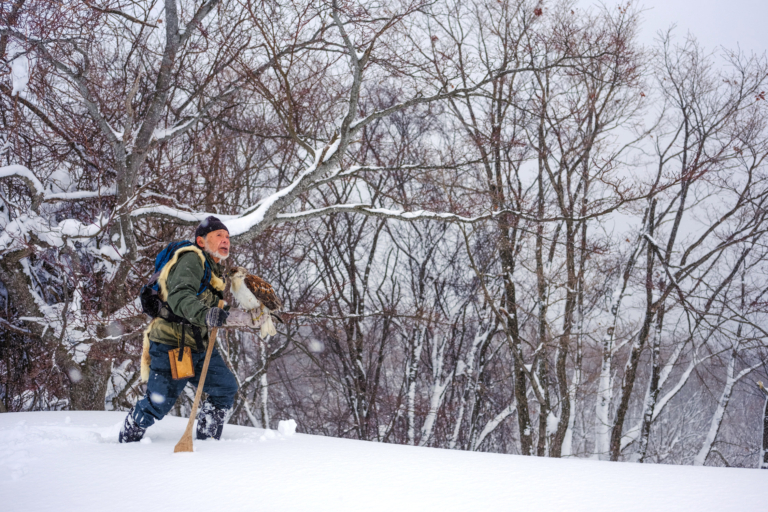
Falconry training takes many hours of the day. But, Matsubara and his hawk just continue on through the snow.
Tōhoku’s mountain valleys are encased in deep snow during winter. Hunting season with mountain hawk-eagles lasts from December to April.
Hidetoshi Matsubara—a resident of the snowy hamlet of Tamugino in Yamagata Prefecture’s Tendō City—has long been fascinated by falconry. And for nearly 50 years, his life has revolved around venturing into the mountains with his hawk each winter.
In Japan, those who raise and train hawks and falcons are all generally referred to as takajo. Among the people with this title, Matsubara is indisputably unique. There were once large numbers of falconers who used birds of prey for hunting in the farming valleys of Tōhoku, but today only Matsubara remains.
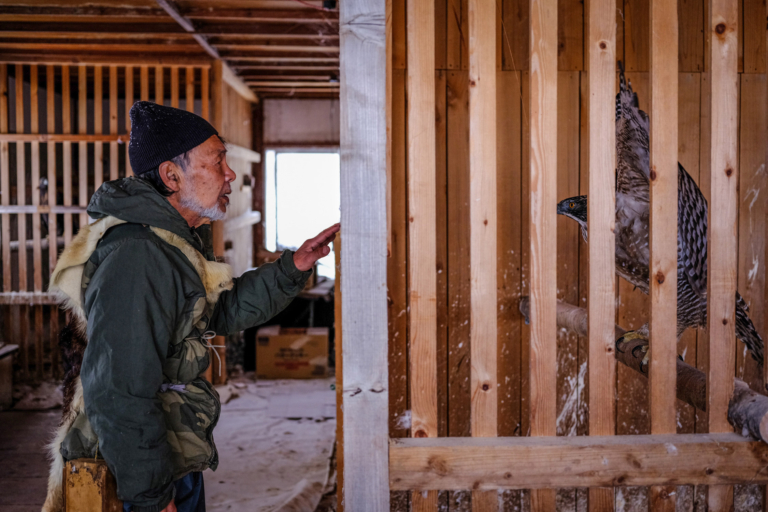
The relationship between a falconer and their bird of prey comes above all else. Matsubara checks in with his mountain hawk-eagle roommate and hunting buddy.
An animal lover from his elementary school days, Matsubara first discovered Tōhoku falconers during his teenage years when he saw a documentary on television called The Old Man and the Hawk. In it, a scene stole Matsubara’s heart—an old falconer sitting in front of a traditional irori (open-hearth fireplace) and giving a drink of warm water to a hawk perched on his arm.
“Seeing a human and a hawk living together as one, I think that even as a child I could really feel that intensely close relationship between different species,” says Matsubara.
During his university years, Matsubara climbed mountains all over Japan and traveled to various mountain villages. Not satisfied with just visiting, he decided to stay in a mountain village and live and work there. At the time, mountain life still felt reminiscent of the ancient ways of living together with nature. As time passed, the memory of The Old Man and the Hawk came rushing back to him anew, and the idea of wanting to live together with animals in a natural environment formed in Matsubara’s mind.
“I’ve been asked, ‘Well, if you wanted to live surrounded by nature, why not be a farmer or a hunter?’” says Matsubara. “But for me, there was no other choice but [to be a] falconer. I first had a feeling that I wanted to live closely connected to nature. And so, of course I felt the appeal of hunting not with a gun but together with a hawk, and I felt like the lifestyle of a falconer was everything that I wanted.”
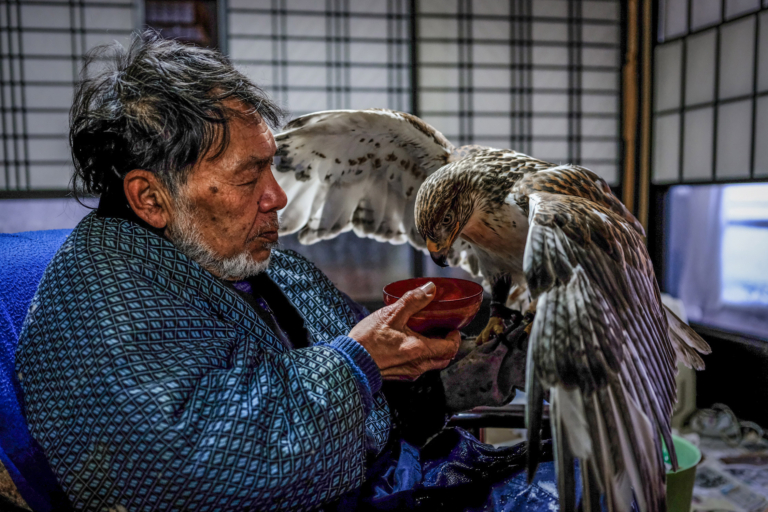
A ferruginous hawk takes a drink of warm water—a mirror image to the film scene that deeply inspired Matsubara.
A graduate of Keio University’s literature department, Matsubara spent a year studying falcon training methods under legendary falconer Asaji Kutsuzawa and then moved to a small hut at the foot of a mountain in northern Yamagata Prefecture to start a solitary life with his hawks. The hut did not have gas, electricity or water, and only lamps and candles provided light, with the nearest home a two-and-a-half-hour walk away. Perhaps an ordinary person would find that kind of life inconvenient and lonely, but it was an ideal place for Matsubara.
In those days, Matsubara’s annual income was only the roughly 250 thousand yen, less than $2,000, he earned from part-time jobs he did during the summer months helping farmers in a nearby village or working at construction sites. He used that money to purchase the bare minimum of food necessities, such as rice, seasonings and canned foods. He grew vegetables in a field close to his hut and picked wild vegetables and mushrooms in the mountains. It was a life truly made possible by the blessings of nature.
“Even without money, I felt happy because I was free,” he says. “I wasn’t constrained by anyone, and I could live the life I’d longed for.”
Falconry can be described as a particularly distinctive hunting method. A typical hunter uses a man-made tool, such as a gun or a trap, to hunt. But falconry uses animals to hunt animals. A hawk finds and attacks prey based on its instinct. But, taking off from a falconer’s arm and then returning with its catch is not instinctively imprinted on a hawk. Falconry requires the falconer to care for the physical health of a hawk and train the bird of prey to become a partner. A close relationship must be built. When it’s done well, a falconer and their bird may even have the same mind in different bodies.
Matsubara is currently raising five birds: a mountain hawk-eagle, a golden eagle, an upland buzzard, a ferruginous hawk and a Harris’s hawk. He trained the ferruginous hawk to be his hunting partner this winter.
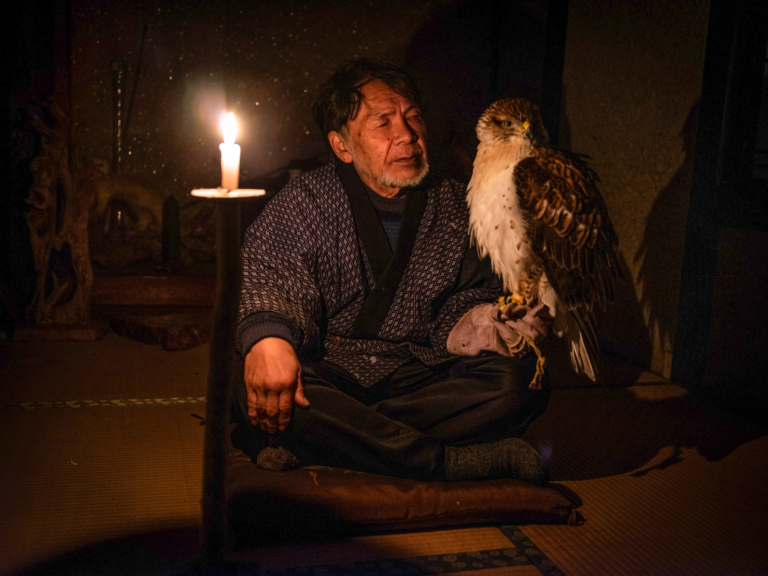
The first stages of “manning,” teaching a hawk to stay on their falconer’s arm, begins with acclimation in the dark. The second phase uses a room that’s dimly lit.
Training begins each year in late October. Untrained hawks are very cautious of humans. For the hawk to stay on the falconer’s arm is known as “manning,” which gradually accustoms them to humans and light, and that bond forms the foundation of falconry. To do this, Matsubara first has a hawk sit on his arm in a dark room. Once the hawk is used to the dark, it then slowly grows accustomed to being with a human in a room dimly lit by candlelight. After the hawk feels comfortable with indoor light, the next step is changing the environment to a daytime room or taking it outdoors at night. Once trained, the hawk can sit properly on the falconer’s arm outdoors during the day.
Once the hawk has been successfully trained to ride on his arm, Matsubara walks through the village every day, except in the case of strong winds, with the bird of prey perched there. While close to his home or in rural terrain nearby, he uses bait and trains the hawk to return to his arm when called and catch prey.
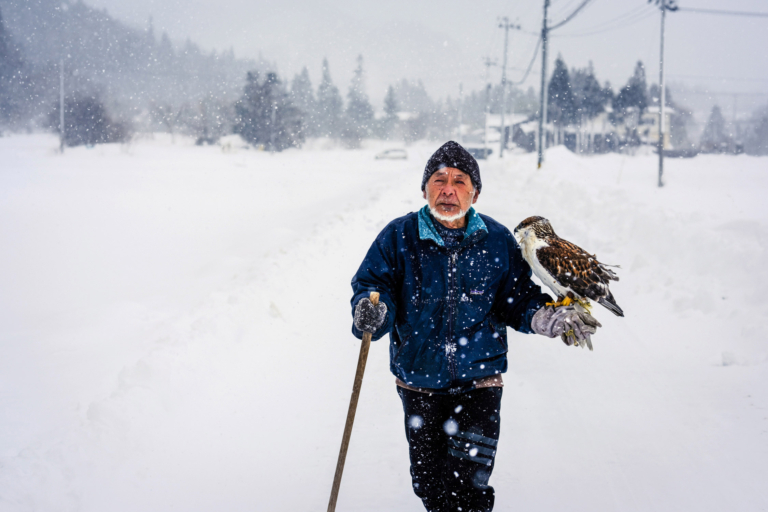
Even in the daylight, temperatures often drop below freezing during Tamugino winters.
Training hawks means truly spending every moment together with them. During manning training, the trainer keeps the hawk on their arm constantly unless they are sleeping or bathing. They do every kind of ordinary task—like eating or reading—with the hawk on their arm. The hawks normally live in the hawk huts, but Matsubara sets up a perch in his room when training begins. And whether day or night, he stays with the hawk in the same room.
Matsubara pays careful attention to even the smallest changes in the hawk. For example, he evaluates the hawk’s physical condition from the color inside its mouth or of its toes, the condition of its eyelids and wings or the color of its droppings.
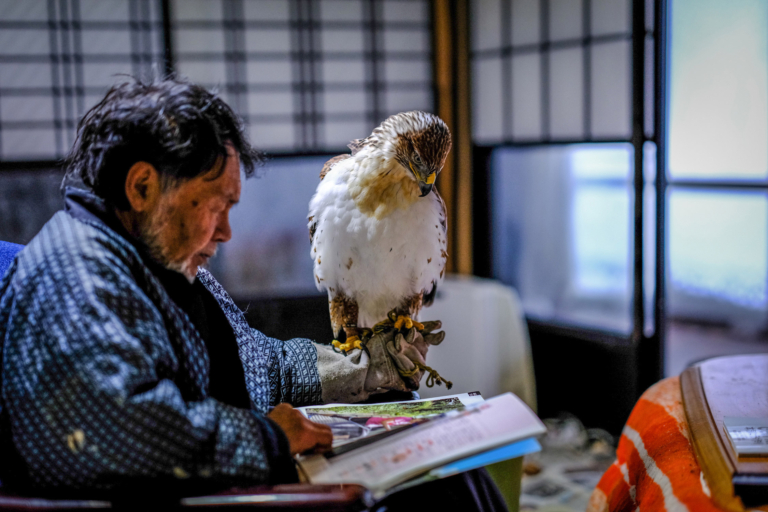
This scene might not seem particularly remarkable at first glance, but it could never occur without the hawk’s sincere trust in the falconer.
Training usually takes between six weeks to two or three months. Spending such long amounts of time together allows for a deeper understanding between the hawk and falconer.
“Unlike people, hawks don’t use words. They don’t express things with facial expressions or gestures,” says Matsubara. “But if you listen to their voices, you can understand their feelings, like ‘I’m angry right now!’ or ‘I’m on the lookout!’”
Matsubara will never forget the moment, three years after moving to his mountain hut, when his first mountain hawk-eagle spread its wings and took off from his arm, soaring in a straight line, and picked up a rabbit with its talons for the first time.
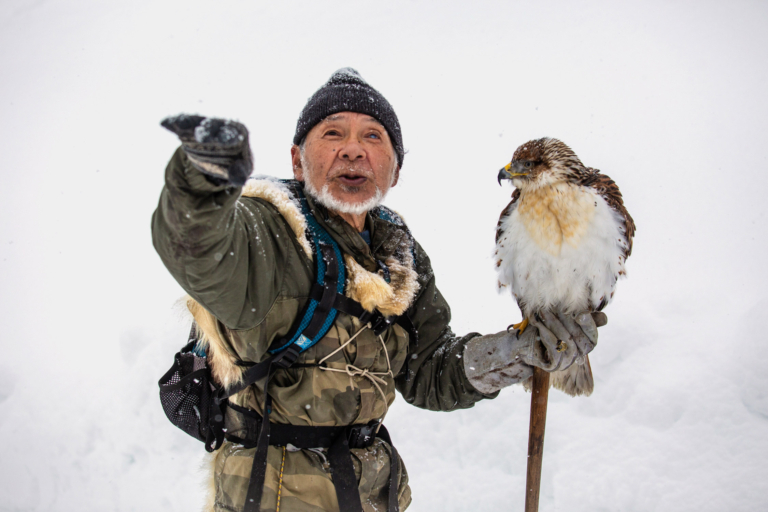
“To me, falconry is being together with the hawk. Living together with the hawk, walking through the mountains together and being able to hunt is enough. I don’t need anything else.” —Hidetoshi Matsubara
“In that moment, I felt an emotion impossible to express in words spread through my body, and I raised my voice and cried out,” he says. “I was just so happy, and from the bottom of my heart I thought, I was born for this day. Perhaps I’ll never feel such intense emotion again.”
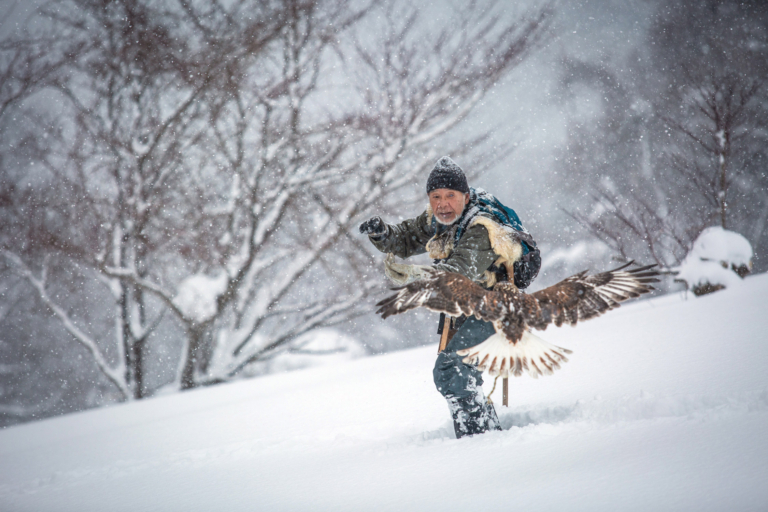
Today’s training is teaching the hawk to return from long distances. When it spots prey, the hawk shoots from Matsubara’s arm like an arrow. In that moment, Matsubara says he is filled with a mysterious sense of having become one with the hawk.
Now, at 71 years old, Matsubara intends to continue living and hunting together with hawks.
“I walk into the otherwise empty snowy mountains with the hawk that I’ve trained bit by bit over time,” he says. “We search for prey and move deeper into the mountains. At times like that, I think, yes, I’m truly happy. To me, falconry is being together with the hawk. Living together with the hawk, walking through the mountains together and being able to hunt is enough. I don’t need anything else.”

